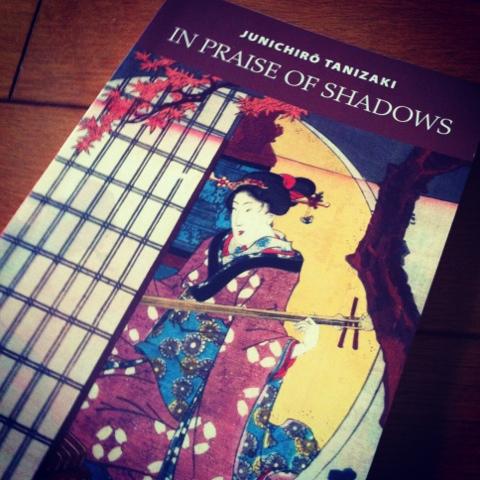El Elogio De La Sombra Junichiro Tanizaki Pdf
Contents. Publication Already sketched out in a series of comments that appear in, Tanizaki's aesthetic credo, in the more finished form of this essay, was originally published in 1933 in. The English translation was published in 1977 by Leete's Island Books. The translation contains a foreword by architect and educator and an afterword by one of the translators, Thomas J.

Harper was Senior Lecturer in Japanese Literature at the in. The other translator, was Professor of Japanese Literature.
Much shorter than the author's novels, this book is a small meditative work of 73 pages, of which 59 are the essay itself. A new English translation by Gregory Starr, with illustrations and photographs by Andrew Pothecary, was published by Sora Books in December, 2017. The 102-page edition also includes a foreword by the Japanese architect Kengo Kuma and an afterword by Japanese literature Professor Eve Zimmerman of Wellesley College.
Themes The essay consists of 16 sections that discuss traditional in contrast with change. Comparisons of light with darkness are used to contrast and.
The West, in its striving for progress, is presented as continuously searching for light and clarity, while the subtle and subdued forms of oriental art and literature are seen by Tanizaki to represent an appreciation of shadow and subtlety, closely relating to the traditional Japanese concept of. In addition to contrasting light and dark, Tanizaki further considers the layered tones of various kinds of shadows and their power to reflect low sheen materials like gold embroidery, patina and cloudy crystals. In addition, he distinguishes between the values of gleam and shine. The text presents personal reflections on topics as diverse as and its fittings, crafts, finishes, food, and (the art of impermanence). Tanizaki explores in close description the use of space in buildings, by candlelight, monastery toilets and women in the dark of a brothel. The essay acts as 'a classic description of the collision between the shadows of traditional Japanese interiors and the dazzling light of the modern age'. In the Sora Books edition, the 16 section themes are:.
On construction. The toilet aesthetic. A different course. A novelist's daydreams. On paper, tin and dirt. Candlelight and lacquerware.
Bowls of broth. The enigma of shadows. An uncanny silence.
Reflections in darkness. Shadows on the stage.
The woman of old. Beauty in the dark. A world of shadows. A cool breeze in total darkness. Final grumblings Cultural notes Tanizaki's observations include cultural notes on topics such as arts and crafts, paper making, lacquerware design and the Japanese room. He gives a recipe for the unusual dish of leaf on pages 60 to 62. He also refers to many historic places and temples, as well as celebrated eateries of the day, along with customs like 'moon-viewing' ( ).
Featured individuals Among the historic and contemporary individuals mentioned in the essay are:., novelist, on the experience of textures and landscape via the traditional Japanese toilet, p. 9; Sōseki's Pillow of Grass, p. 26., poet quoted as saying 'elegance is frigid', p. 10. and, p. 16. Kongō Iwao, Nō actor, p. 39.
Baikō, aging Kabuki actor, p. 43. Takebaya Sanehiko, president of (which had published Tanizaki's earlier novel ), p. 54., scientist, p. 54. Reception The work has been praised for its insight and relevance into issues of modernity and culture, and Tanizaki has been called an 'ecological prophet'. Has described Tanizaki's essay on Japanese taste as a 'hymn to nuance' and an exercise in mindfulness.
Junichiro Tanizaki selects for praise all things delicate and nuanced, everything softened by shadows and the patina of age, anything understated and natural—as for example the patterns of grain in old wood, the sound of rain dripping from eaves and leaves, or washing over the footing of a stone lantern in a garden, and refreshing the moss that grows about it – and by doing so he suggests an attitude of appreciation and mindfulness, especially mindfulness of beauty, as central to life lived well. In the spirit of Tanizaki juxtaposing the cultures of east and west, Grayling notes a link to a similar approach and emphasis in the British writer whose late Renaissance essay he quotes, 'The service of speculative culture towards the human spirit is to rouse, to startle it to a life of constant and eager observation'. Grayling concludes that the difference between the two essayists lies in the 'tranquility' of Tanizaki and the 'intensity' of Pater. In 2001, published a reprint in paperback.
Elogio De La Sombra Junichiro Tanizaki Pdf
Regarding the new translation published by Sora Books, David Mitchell, author of Cloud Atlas, wrote, 'A rhapsodic meditation on a vanishing world, its aesthetics and its values. Gregory Starr's new translation is pitch perfect and transparent.' Stephen Mansfield, in the Japan Times wrote, 'Tanizaki, in Gregory Starr’s new and highly accomplished translation, samples a number of instances where the use and perception of light differs from the West, noting that, where Western paper reflects light, traditional Japanese paper absorbs it.' References.
^ Grayling, A. (October 5, 2002). Privy Counsels. Retrieved 8 November 2008.
Grayling, A.C. (October 5, 2002). Privy Counsels.
Retrieved 8 November 2008. Readers of Tanizaki are variously startled or entertained to find that his essay on the delights of what is muted, enclosed and refined by shadows, begins with a paean to the lavatories found in Japanese monasteries. Jacket notes, Vintage Classics 2001 edn. Jun'ichirō Tanizaki (1933). In Praise of Shadows.
Jorge Luis Borges Elogio De La Sombra
^ Sowin, Joshua (23 September 2008). Retrieved 8 November 2008. External link in work=.